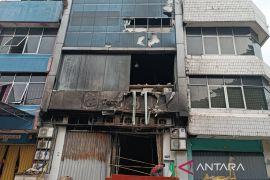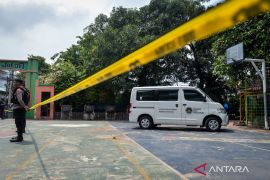Jakarta puts forward three important issues in its development plans and implementation: social cohesion, the environment, and collaboration between the government and citizens, which are the keys to London’s success.Jakarta (ANTARA) - Last January, 10 media outlets covered Jakarta Governor Anies Baswedan's visit to South Jakarta's newly developed Tebet Eco Park to be opened to the public soon and among the capital city's almost 300 restructured parks.
On his Instagram account @aniesbaswedan, the governor stated that the revitalization of Tebet Garden (Taman Tebet) aligned with the vision of ecological restoration. “The concept of Eco Park in the revitalization has a mission to restore its role from an ecological perspective,” according to Baswedan.
The governor explained that Tebet Park has altered the function of a green space at the park into a green open space. It is also applied as a blue open space to address the problems of flooding and water crisis in Jakarta.
“Restoring natural rocks and plants, garden animals, and for accessibility to natural features in the park or what we call naturalization,” Baswedan remarked.
It all started with the aspirations of the surrounding residents. They beautified Tebet Park with a natural bridge, called "infinity connecting bridge," in a form of the figure eight (8) that connects two separated north and south Tebet parks, Taman Tebet Utara and Taman Tebet Selatan.
Related news: Jakarta, W Java governors discuss preparations for Youth 20 Summit
The bridge is expected to become an icon of the seven-hectare park. The area has eight sections: Forest Buffer, Link Bridge, Community Lawn, Wetland Boardwalk, Children Playground, Plaza, Community Garden, and Thematic Garden.
The project is an effort to build a capital city that is not solely focused on urban development but is equally a source of contentment for its citizens, as campaigned by Anies Baswedan during the 2017 Jakarta gubernatorial election. Organized in the past four years, one program promoted by the Jakarta government is to add more public areas, also called the “third space” (“ruang ketiga”). The plan was ensured under the authority of the former education minister, as no less than 296 city parks, 29 urban forests, and 154 green lines were built.
The idea was to create a place that was merely a “garden” for plants into a “park,” an open area with more functional features that provides a location for studying, playing, and interacting between citizens. Events or festivals are held often, so that the park is not an empty field amid the swift and hectic metropolitan currents.
“That feeling of equality is what is needed in this city,” Baswedan noted. It is important to note since the governor wants a unified Jakarta, which means the "third space" should not be segmented or divided.
However, development of the park is not without problems. On account of the COVID-19 pandemic, the constructions paused and continued in the year 2021 with 12 “Progress Together Park” (Taman Maju Bersama, or TMB). The number of TMBs built until the end of 2021 totaled 69, while the target was to develop 200 TMBs by the end of 2022 when Baswedan ends his term as governor. However, the outbreak has delayed the expansion, as health and safety are prioritized. Several parks in Jakarta even switched to serving as places for swab tests and as COVID-19 vaccination centers.
Related news: Nutrition must be taught in schools: Jakarta health office
However, three parks were successfully built as the ideal "third space," which were called as "TMB Grande." Grande Park is a large-scale park, as a green open space and a land for water retention. These places have a "fun transit park" concept, with a comfortable transit place for pedestrians since it integrated them into public transportation. The three parks are Taman Mataram in Kebayoran Baru, South Jakarta, Taman Puring in Kebayoran Lama, South Jakarta, and the Tebet Eco Park.
The parks that were earlier rarely glimpsed have today become the residents’ destinations to spend time or unwind on the weekends instead of the malls. The individuals interviewed by the media also acknowledged the benefits of the parks for their young ones. As local residents, they no longer need to look for a remote location to keep their kids entertained. Apart from being free, parents can unwind and rest, as it is easy to supervise their children.
Related news: Jakarta gov't conceives future development plan as economic centre
Sidewalks and tunnels for pedestrians
No less relevant than the parks in Jakarta are the 214 kilometers of walkways built, including the renewals of 10 sidewalks, or trottoirs, on the major streets of Jakarta. In addition, another significant step is converting public routes into pedestrian areas, such as the underpass on Jalan Kendal next to Sudirman Station. The tunnel, which was always a point of congestion during work hours, has now become one of the most aesthetic places in Jakarta. This tunnel is not only used as a place for pedestrians to pass from one point to another but also a destination for holding events or taking pictures for social media feeds.
It takes consistency and commitment from a leader to establish green open spaces that are comfortable, safe, and accessible to all citizens in the midst of rapid skyscraper constructions. The government is targeting a bigger percentage of green open spaces in Jakarta and has so far reached 9.2 percent.
It seems that Jakarta wants to emulate London, which was named the most environmentally friendly city by the IESE Cities in Motion Index (CIMI) 2020, University of Navarra, Spain. One of London’s outstanding achievements is the realization of an eco-friendly city, with over three thousand green spaces and parks that occupy 40 percent of the land in the British capital.
Related news: Jakarta should boost digitalization after IKN relocation
Jakarta puts forward three important issues in its development plans and implementation: social cohesion, the environment, and collaboration between the government and citizens, which are the keys to London’s success. In determining the ranking of cities in the world, CIMI analyzes 101 indicators that are divided into nine dimensions that Jakarta seems to be promoting: human capital, social cohesion, the economy, governance, the environment, mobility, and transportation, urban planning, international projection, and technology.
For almost five years, Jakarta continues to strive for its progress and happiness of its citizens. Apart from the Indonesian Happiness Index, which states DKI Jakarta is in the 27th position out of 34 provinces and criticism from opposing parties, data shows that the parks, sidewalks, and green open spaces built had increased the number of smiles on the faces of millions. It is possible that the "third space" will set an example for other big cities in Indonesia, with forms of entertainment in open spaces being in high demand, especially during a pandemic.
It is time for the development of City 4.0, parks, urban forests, and comfortable sidewalks to become the trend of future metropolitan cities and not malls, skyscrapers, luxury cars, and motorbikes that fill the streets.
*Syafiq Basri Assegaff is lecturer at LSPR Communication and Business Institute, Jakarta.
The views and opinions expressed on this page are those of the author and do not necessarily reflect the official policy or position of the ANTARA News Agency.
Related news: Football coach optimistic of players' naturalization being bolstered
Related news: Indonesia to prioritize AstraZeneca as booster vaccine in Q1 2022
Copyright © ANTARA 2022












